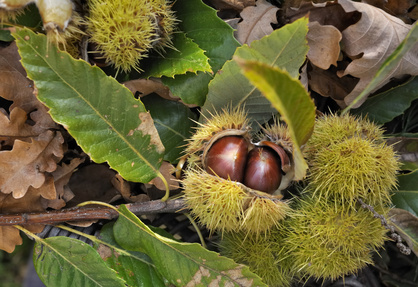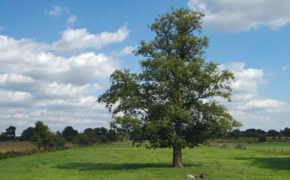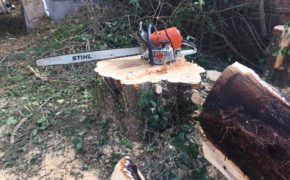
Get a quick no obligation quote It’s free and will only take a jiffy!
Sweet Chestnut Tree Pruning – When’s the Best Time?
When is the right time to prune a sweet chestnut tree? Why is sweet chestnut tree pruning essential? What are the most common sweet chestnut tree diseases? Read on for all the answers you need.
The sweet chestnut, of the Latin Castanea vesca, is a deciduous tree that will often grow up to 35 metres in height. Its trunk can grow to two metres in diameter, and it is not uncommon for this tree to live up to 700 years.
The sweet chestnut tree is not native to the UK, but it is commonly found throughout Britain in copses and woods, particularly in areas of Southern England. Its timber is fairly similar to oak but a little more lightweight. The grain is straight in younger trees then forms a spiralling effect when more mature.
Sweet chestnut is regularly used in joinery, carpentry and furniture making and is coppiced in south east England to make poles. The fruit of the sweet chestnut tree usually falls between mid-September and mid-October and can be roasted to use in a range of recipes, including Christmas stuffing.
Why prune a sweet chestnut tree?
The sweet chestnut tree tends to take care of itself once mature, so pruning is primarily undertaken to keep the tree healthy and safe and to prevent it blocking light.
Pruning a sweet chestnut tree is also a good way to increase chestnut production.
As with most trees, the sweet chestnut will produce shoots that can get congested or veer off in all directions. This can make the tree appear less than attractive, plus congested shoots are not good for the tree’s health as they can restrict airflow and light penetration, both of which are vital. Regular sweet chestnut tree pruning is therefore advised, and is also important in order to ensure the removal of any dead wood.
When is the best time for sweet chestnut tree pruning?
Sweet chestnuts should only be pruned when they are dormant, which is during the winter.
If your aim is to reduce or limit the height of your sweet chestnut tree, then choose a dry winter day to carry out the work. If you start pruning during wet weather or even when it is forecast, you will invite disease into the tree via the rain which carries infection inwards through the pruning wounds.
If you have spotted any damaged or diseased branches, however, then be sure to act immediately rather than wait until winter. Any time of year is fine if you are looking to maintain the health and safety of the tree, but do try to act on a dry day wherever possible.
What to look for when pruning a sweet chestnut tree
Sadly, many of the UK’s tree species are under threat from imported diseases and pests. Managers and owners of sweet chestnut trees are being urged to check their trees by the Forestry Commission following the discovery of a tree in 2016 that was suffering from chestnut blight.
Chestnut blight (Cryphonectria parasitica) is a fungus that infects and kills chestnut trees. It led to a near wipe-out of North America’s sweet chestnut trees during the 19th and 20th centuries after it was introduced accidentally from Asia. It then became widespread across Europe after being introduced in the 1930s.
A fact sheet detailing the symptoms of chestnut blight can be found on the Forestry Commission website.
As well as this disease, a relatively new pest has started to attack the sweet chestnut tree: the oriental chestnut gall wasp (Dryocosmus kuriphilus).It was first discovered in Kent in 2015 but has since spread to numerous places across London and South East England.
The combination of the blight and the wasp has the potential to be devastating, particularly where the tree is cultivated for nut production, timber and coppicing. If you have any concerns about sweet chestnut trees on your land or even in your local area then be sure to report them through the Forestry Commission Tree Alert webpage.
Tree Preservation Orders
A Tree Preservation Order (TPO) prohibits any sort of tree work without permission. Be sure to ascertain whether an Order is in place before going ahead and, where necessary, make an application to the local authority for permission. This can take up to eight weeks. Also be aware that if the tree is situated in a conservation area, permission must be obtained before undertaking works of any kind.
The importance of sweet chestnut tree pruning expertise
Due to the threat of chestnut blight and the chestnut gall wasp, it is essential to bring in professional, qualified assistance when seeking to undertake any sort of sweet chestnut tree pruning. Be sure to engage an experienced tree surgeon who can provide checkable references and certificates to prove they have the relevant knowledge to carry out the work you require.
When selecting a tree surgeon, make sure you request insurance documentation so you have complete reassurance that you are covered for the work being undertaken. Wherever possible, try to engage a tree surgeon with Trading Standards and local authority approval.
If you have sweet chestnut tree that needs pruning, or you are concerned about chestnut blight, why not contact T.H. Tree Services? As fully qualified and extensively experienced Trading Standards and local authority approved tree surgeons, we can provide specialist expertise across all aspects of sweet chestnut tree pruning. For a free, no-obligation quotation, contact our friendly experts on 01268 642814 or get in touch here.
Had a fallen tree in the early hours of Monday morning, called for quote and the team had it cleared on the same day. Really good communication when the lads were onsite and did a great job. Lots of pride in their work shown with the thorough clear up. Would thoroughly recommend.
Thank you Stuart for your kind review. We were glad to be able to help you with your fallen tree. If there's anything else you need in the future, please don't hesitate to get in touch.








